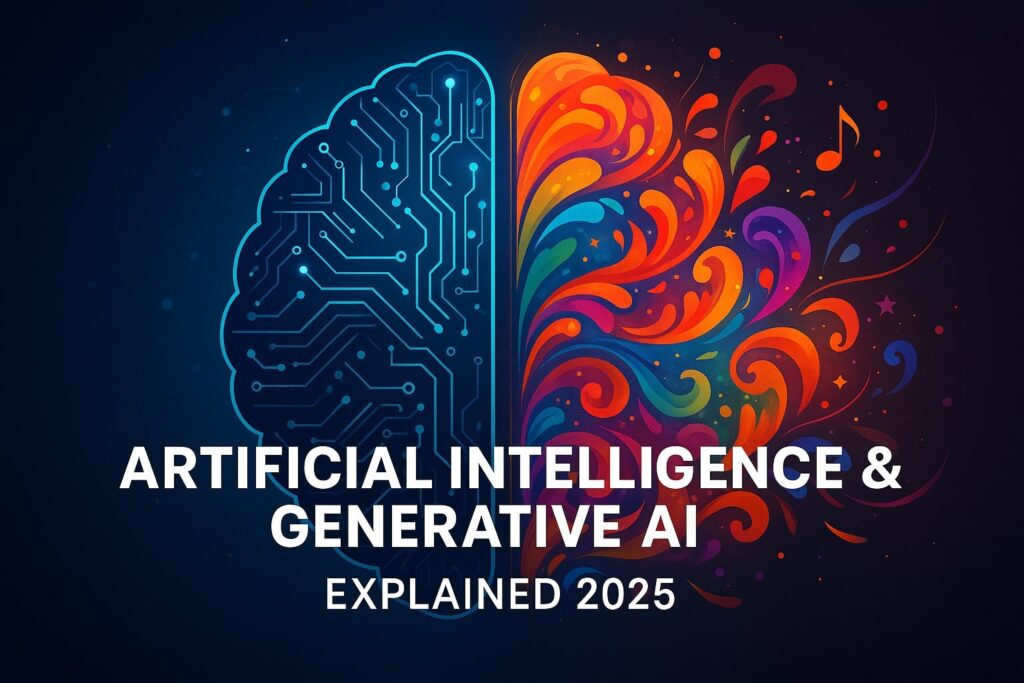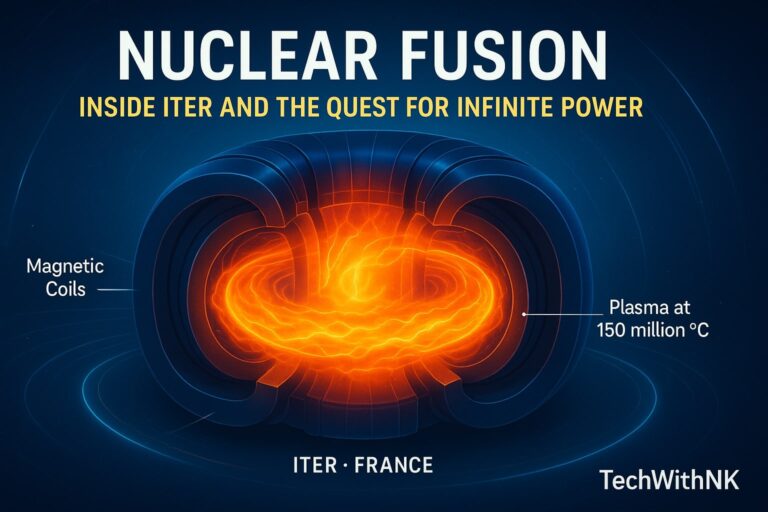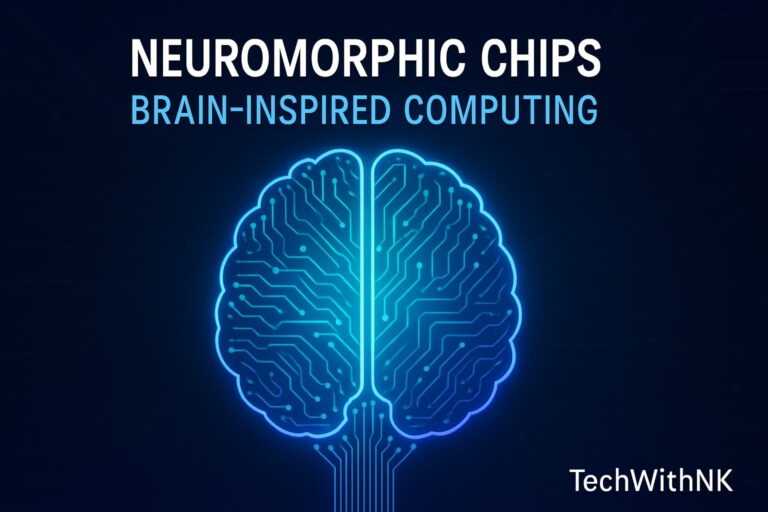Introduction to Artificial Intelligence
Artificial Intelligence (AI) has become one of the most transformative technologies of the 21st century. From voice assistants like Alexa and Siri, to AI-powered medical diagnostics, to self-driving cars, AI is everywhere.
In simple terms, AI is the ability of machines to simulate human intelligence. It allows computers to learn, reason, solve problems, and even create content.
In recent years, a new branch of AI called Generative AI has gained global attention. Unlike traditional AI, which analyzes and predicts, Generative AI creates — it writes text, generates images, composes music, and even designs software code.
This blog will dive deep into AI and Generative AI, covering their history, working principles, applications, risks, and the future ahead.
History & Evolution of AI
The idea of creating machines that can “think” has fascinated humans for centuries. Let’s take a quick journey:
1950s – The Birth of AI: Alan Turing proposed the “Turing Test” to check machine intelligence. The term “Artificial Intelligence” was coined in 1956 at the Dartmouth Conference.
1960s–1980s – Early AI Systems: Expert systems were developed that could mimic human reasoning in limited domains.
1997 – IBM’s Deep Blue: Defeated chess champion Garry Kasparov.
2011 – IBM Watson: Won the Jeopardy quiz show.
2012 – Deep Learning Revolution: Breakthrough in image recognition with deep neural networks.
2020s – Generative AI Boom: Tools like GPT, DALL·E, MidJourney, and Stable Diffusion revolutionized creativity.
AI has evolved from simple rule-based systems to complex deep learning models with billions of parameters.

Core Concepts of AI
3.1 Machine Learning (ML)
ML is the backbone of AI. Instead of programming rules, machines learn patterns from data.
Supervised Learning: Labeled data (e.g., spam detection).
Unsupervised Learning: No labels, finds hidden patterns (e.g., customer segmentation).
Reinforcement Learning: AI learns by trial and error (used in robotics & gaming).
3.2 Deep Learning (DL)
DL uses artificial neural networks with multiple layers. Inspired by the human brain, DL powers image recognition, speech-to-text, and generative models.
3.3 Natural Language Processing (NLP)
NLP helps machines understand and generate human language. Chatbots, translation apps, and generative text tools are based on NLP.
3.4 Computer Vision (CV)
CV enables machines to interpret images and videos. Applications include self-driving cars, medical imaging, and facial recognition.
What is Generative AI?
Generative AI refers to AI systems capable of creating new data or content similar to what they’ve been trained on.
Examples include:
Writing blogs & articles (ChatGPT, Gemini).
Creating realistic images (MidJourney, DALL·E).
Composing music (AIVA, MuseNet).
Generating code (GitHub Copilot, CodeWhisperer).
Generative AI uses advanced neural networks like Transformers, GANs, and Diffusion Models to generate high-quality output.

Generative AI vs Traditional AI
| Feature | Traditional AI | Generative AI |
|---|---|---|
| Main Function | Analysis, prediction, classification | Creation of new content |
| Example | Predict stock prices | Generate an image of “a cat flying in space” |
| Techniques | Regression, classification, clustering | GANs, Transformers, Diffusion |
| Output | Labels, scores, decisions | Text, image, audio, video |
| Use Cases | Fraud detection, spam filtering | AI art, Chatbots, Deepfakes |
Technologies Behind Generative AI
Transformers (GPT, BERT, Gemini): Handle sequential data like text.
GANs (Generative Adversarial Networks): Two networks compete, generating realistic images/videos.
Diffusion Models (Stable Diffusion): Gradually create images by denoising random noise.
Applications of AI Across Industries
Healthcare
AI-assisted diagnosis (detecting cancer, heart disease).
Drug discovery.
Personalized medicine.
Education
AI tutors & adaptive learning.
Automated grading.
Generative AI for creating study material.
Finance
Fraud detection.
Algorithmic trading.
Chatbots for banking.
Manufacturing
Predictive maintenance.
Smart robots in factories.
Generative design for new products.
Transportation
Self-driving cars.
AI traffic management.
Predictive logistics.
Entertainment & Media
Netflix recommendations.
AI-generated films, music, and games.
Content creation (articles, blogs, social media).

Generative AI Applications
Text: ChatGPT, Gemini, Jasper.
Images: DALL·E, MidJourney, Stable Diffusion.
Video: Runway Gen-2, Pika Labs.
Music: OpenAI Jukebox, AIVA.
Code: GitHub Copilot, Amazon CodeWhisperer.
Benefits of AI & Generative AI
Automation of repetitive tasks.
Creativity boost for writers, designers, musicians.
Cost efficiency for businesses.
Accessibility: AI tools help differently-abled individuals.
Personalization: Tailored ads, learning, healthcare.
Risks & Challenges
Bias in AI datasets.
Deepfakes & misinformation.
Job displacement.
Privacy concerns.
Over-reliance on AI.
Responsible AI & Regulations
Countries are working on AI ethics frameworks:
EU AI Act (2024).
India’s AI Task Force.
US AI Bill of Rights.
Key principles: transparency, fairness, accountability, and human oversight.
Future of AI & Generative AI (2025–2035)
AI copilots in every profession.
AI-generated movies & video games.
Human-AI collaboration in science.
Rise of Artificial General Intelligence (AGI).
AI for sustainability (climate change, energy optimization).

Case Studies
India: Aadhaar biometric system, AI in UPI fraud detection, AI in agriculture.
Global: Tesla Autopilot, AlphaFold (protein folding), OpenAI GPT-5, Google Gemini.
How Businesses Can Adopt AI
Start with small AI use cases.
Use cloud-based AI tools.
Train employees in AI literacy.
Ensure ethical AI deployment.
Conclusion
Artificial Intelligence and Generative AI are reshaping industries, creativity, and daily life. While the opportunities are endless, responsible usage is critical to ensure AI benefits society rather than harms it. The future will be a human-AI collaboration, not competition.
What is the difference between AI and Generative AI?
AI focuses on analysis and prediction, while Generative AI creates new content such as text, images, or music.
Is Generative AI safe?
It can be safe if used responsibly, but risks like misinformation, deepfakes, and bias exist.
How is Generative AI used in business?
For content marketing, design, customer support, and rapid prototyping.











